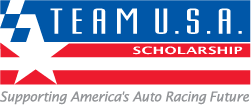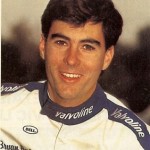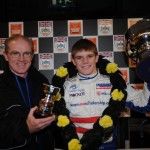The Team USA Scholarship has evolved into a labor of love for a variety of people since its inception in 1990, and while it has surely been responsible for a large number of gray hairs, it has also resulted in an enormous amount of satisfaction. More importantly, it has provided a significant boost in the early career development of some extremely talented young American drivers.
The program was initiated at a time when young Americans were finding it especially tough to make “the next step” up the auto racing ladder. Racers were also feeling the pinch in England, where a proliferation of developmental categories had resulted in the cancellation of some British Formula Ford Championship races that year due to a lack of entries. (Formula Ford had been the primary stepping stone for youngsters since the late 1960s, and traditionally the highlight of the season was the Formula Ford Festival which attracted as many as 200 drivers from around the world to an end-of-season knock-out competition at Brands Hatch. The Festival included an additional “World Cup” element whereby drivers scored points for their home countries.)
It seemed logical to assume that if races were being canceled, perhaps the future of the “Festival” was in
jeopardy; also, if entries were thin, perhaps a talented young American could go over to England and achieve some success….. So, at very short notice, after a conversation with SportsCar magazine publisher and fellow Formula Ford enthusiast Paul Pfanner, some feelers were put out to gauge interest.
Renowned FF engine builder Jay Ivey pledged his support immediately. So, too, did Indy Car team owner Rick Galles. Ford Special Vehicle Operations also provided some valuable financial support.
The program was up and running.
Two drivers were contacted with a view to contesting the 1990 Formula Ford Festival at Brands Hatch: Jimmy Vasser, who was racing successfully in the Canadian Export A Formula Ford 2000 series, and Jeff Gordon, then an extremely promising USAC Midget racer. Both expressed immediate interest and enthusiasm, although Gordon had to bow out due to a Midget conflict. So Vasser became our first Scholarship winner. And when he arrived at Brands Hatch, he was stunned to discover an entry of almost 200 cars, which were divided into eight Heat races. It was one of the largest fields the Festival had ever seen. So much for the event being on its last legs!
From a results standpoint, the foray was disastrous. Vasser had very little testing, in an unproven car, and he was involved in a crash on the first lap of his heat race. But he learned a great deal and even now looks back on the trip with fond memories.
“I had a fantastic time,” remembers Vasser. “I couldn’t believe how intense the whole thing was, and how competitive it was. We didn’t get the results we wanted but it was still a great experience.”
The Scholarship grew rapidly from that low-key beginning. The following year, 1991, saw Bryan Herta carry
the patriotic red, white and blue colors on a proven Reynard chassis which boasted additional support from Valvoline and TWR (Tom Walkinshaw Racing) as well as contributions from Indy/Champ Car team owners Steve Horne, Carl Haas and Bobby Rahal. The car’s livery was designed by David Aronson, who along with Paul Pfanner (who later founded RACER magazine) and Steve Horne continued to play a major role in the development of the Team USA Scholarship.
In 1995, with Formula Ford again going through the doldrums following a decision to replace the trusty Kent engine with the newer Zetec motor, the decision was made to enter that year’s Team USA Scholarship winner, Memo Gidley, in a non-championship end-of-season International Formula 3 race at Donington Park in England. It was a productive exercise but relatively expensive. One year later, a more cost-effective alternative was located when, coincidentally, the Formula Opel “Nations Cup” switched to Donington Park. It proved an excellent fit. The event featured two-car teams, each with cars painted in national color schemes. It was well-promoted – coincidentally by a European-based American, Dan Partel, and his European Formula Drivers Association – and enjoyed a high profile which included a one-hour television broadcast.
For ’99, the focus shifted to Formula Palmer Audi in the UK, providing a four-race Winter Series and unparalleled value for money, while in 2001/2002 the Team USA Scholarship went back to its roots while entering some talented youngsters in the equally competitive New Zealand Formula Ford International Series of races. The switch to the Southern Hemisphere was especially attractive due to favorable currency exchange rates.
The primary goal had always been to provide cost-effective opportunities at a level that will most benefit the chosen Team USA Scholarship recipients. In 2005, that led to a return to the Formula Palmer Audi Autumn Trophy, but in 2008, the chosen scholarship winners didn’t possess enough experience to cope with the 350hp wings-and-slicks FPA cars, so they were given a more appropriate opportunity to contest both the world-famous Formula Ford Festival at Brands Hatch as well as the increasingly relevant and popular Walter Hayes Trophy event (named in honor of one of the founders of Formula Ford) at Silverstone.
Happily, since then the program’s reach and credibility has continued to expand, which has allowed the introduction of a “second tier” level, beginning with an entry in the senior Formula Ford Duratec category in 2011 and then a switch to the popular and extremely competitive Formula Renault BARC Winter Series in 2012.


